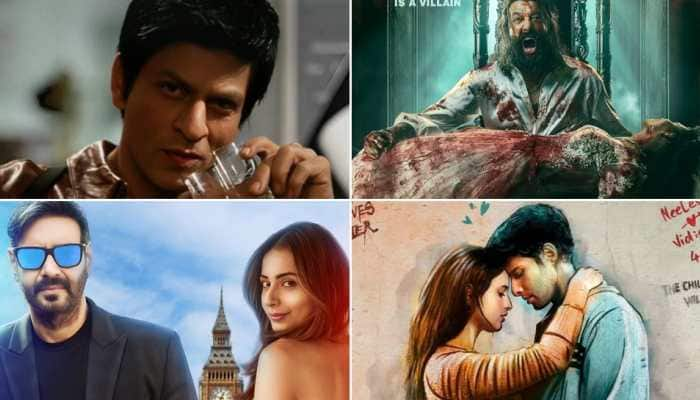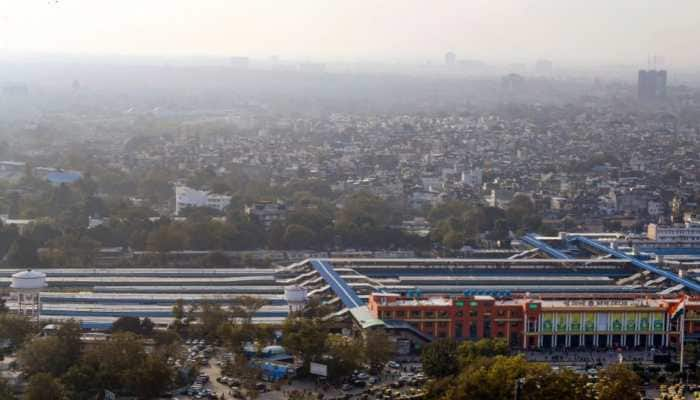Lata Mangeshkar's lasting legacy: Lilting lullabies, love-songs, leg-shakers to hot, high-paced, haunting & heavenly
In a music career spanning over seven decades, Lata Mangeshkar has bequeathed a rich treasure trove of immortal songs that are ingrained in the minds of as many generations of music lovers.
Trending Photos
) Pic Courtesy: Instagram
Pic Courtesy: Instagram NEW DELHI: In a music career spanning over seven decades, Lata Mangeshkar has bequeathed a rich treasure trove of immortal songs that are ingrained in the minds of as many generations of music lovers.
Starting in the black-and-white era when film songs were often recorded in congested studios or even in the open at the dead of night, to the modern-day 'auto-tuners', Lata blazed a glitzy comet-like trail that will dazzle for many millennia.
Her singing legacy comprises lilting lullabies, love songs, love-lorn numbers, leg-shakers, haunting, heavenly, high-paced, both solos and duets, classical and commercial, in multiple languages, rendered with ease.
She developed an unprecedented style of singing -- moulding her voice to suit the particular heroine on whom it would be shot on the screen -- like her male counterpart, the equally legendary Mohammed Rafi did with aplomb, and who remains evergreen 41 years after his death in July 1980, aged 55.
Dipping from the Melody Queen's vast repertoire of music would be tad unjustified and also akin to emptying a jug of water from the musical ocean... but there are definitely a few nuggets that are universally acclaimed and remain alltime favourites of millions.
After the initial mandatory days of struggle starting with playback singing for the Hindi film industry in 1945, she found a toehold with a Naushad Ali composition "Uthaye Ja Unke Sitam" (Andaz - 1949) which catapulted her to the Big League.
Besides Naushad, top music directors of the era like Shankar-Jaikishan, S.D. Burman, Husanlal-Bhagatram, C. Ramchandra, Salik Chowdhury, Khayyam, Ravi, Sajjad Hussain, Roshan, Kalyanji-Anandji, Madan Mohan, Vasant Desai, Sudhir Phadke, Laxmikant-Pyarelal, Usha Khanna, vied for her voice for their varied music for the top heroines or vamps, and she obliged all.
As her popularity charts zoomed, she started to tick off -- literally and figuratively -- all competition from many of the old, established female singers and by the mid-1960s, as producers-directors lined up to ensure her 'all-women compatible' voice was lip-synced by their actresses.
And she did full justice to the heroines and music-directors and their ever-increasing aspirations with a wide range of numbers for the next over four decades, labelled as the 'golden era' of Indian film music.
Some of the ever-hummable, blockbuster, solos filmed on various lead heroines (some vamps, too) include: "Hava Mein Udta Jaaye" ('Barsaat'), "Chale Jaana Nahin Nain Milake" ('Badi Bahen' - both 1949), "Raja Ki Aayegi Baraat" ('Aah' - 1953), "Man Dole Mera Tan Dole" ('Nagin' - 1954), "Rasik Balmaa" ('Chori Chori' - 1956), "Nagari Nagari, Dware Dware" ('Mother India' - 1957), "Aaja Re Pardesi" ('Madhumati'), "Unko Ye Shikayat Hai Ki Hum" ('Adaalat' - both 1958), "Tere Sur Aur Mere Geet" ('Goonj Uthi Shehnai' -1959).
There are the gems from 'Mughal-E-Azam' (1960) like "Pyar Kiya To Darna Kya", "Mohabbat Ki Jhoothi Kahani Pe Roye", "Hamein Kaas Tumse Mohabbat Na Hoti", "Khuda Nigehbaan Ho Tumhara", "Bekas Pe Karam Kijiye"; "Ajeeb Dastan Hai Ye" ('Dil Apna Aur Preet Parayi'), "O Sajana, Barkha Bahar Aayi" ('Parakh'), "Tera Mera Pyaar Amar" (Asli Naqli - all 1960), "Allah Tero Naam, Ishwar Tero Naam" ('Hum Dono'), "Do Hanson Ka Joda" ('Ganga Jamuna'), "Jyoti Kalash Chhalke.. ('Bhabhi Ki Chudiyan' - all 1961), "Tere Pyar Me Dildar" ('Mere Mehboob' - 1963), "Aaja Aayi Bahar" ('Rajkumar'), "Main Kya Karu Ram, Mujhe Budhha Mil Gaya ('Sangam'), "Lag Jaa Gale Se" ('Woh Kaun Thi' - All 1964), "Kaanto Se Kheench Ke Ye Aanchal" ('Guide'), "Ye Samaa, Samai Hai Ye Pyaar Ka" ('Jab Jab Phool Khile' - both 1965), "Tu Jahan, Jahan Chalega", "Nainon Me Bhadra Chhaye" ('Mera Saaya'), "Rahe Na Rahe Hum" ('Mamta'), "Neel Gagan Ki Chhaon Mein" ('Amrapali' - all 1966), "Raat Aur Din, Diya Jale" ('Raat Aur Din' - 1967), "Main To Bhool Chali Babool Ka Des" ('Saraswatichandra' - 1968), "Bindiya Chamkegi, Chudi Khankegi" ('Intaqam' - 1969).
Then came: "Babool Pyare" ('Johny Mera Naam' - 1970), the 'Pakeezah' blockbusters of 1972 - "Chalte, Chalte", "Inhi Logon Ne", "Mausam Hai Aashiqana", "Thare Rahiyo"; "Aaj Socha To Aansoo Bhar Aaye" ('Hanste Zakham' - 1973), "Yeh Raatein Nayi Purani" ('Julie') "Aa, Jab Tak Hai Jaan" ('Sholay'), "Nahin Nahin, Jaana Nahina ('Zinda Dil' - all 1975), "Mere Ghar Aayi Ek Nanhi Pari" ('Kabhie Kabhie'), "Dil Me Tujhe Bithake" ('Fakira'), "Husna Haazir Hai" ('Laila Majnu' - all 1976), "Dil To Hai Dila ('Muqaddar Ka Sikandar'), "Satyam Shivam Sundaram" ('Satyam Shivam Sundaram' - both 1978), "Jaane Kyun Mujhe" ('Agreement' - 1980), "Mere Naseeb Me" ('Naseeb' - 1980), "Tune O Rangeele Kaisa Jaadu Kiya" ('Kudrat' - 1981), "Dikhayi Diye Yun" ('Bazaar' - 1982), "Ae Dil-e-Naadan" ('Razia Sultan'- 1983), "Sun Sahiba Sun" ('Ram Teri Ganga Maili' - 1985), "Patzhar Saavan, Basant Bahar" ('Sindoor' - 1987),
The singles apart, she rendered many memorable duets with G.M. Durrani, Mohammed Rafi, Kishore Kumar, Mukesh, Mahendra Kapoor, Manna De, S.P. Balasubrahmanyam, Shamshad Begum, Nitin Mukesh, Anwar, Shabbir Kumar, Asha Bhosale, etc. and the younger lot of singers who took over after the veterans faded from the scene, over the decades.
Stay informed on all the latest news, real-time breaking news updates, and follow all the important headlines in india news and world News on Zee News.
Live Tv







)
)
)
)
)
)
)
)
)
)
